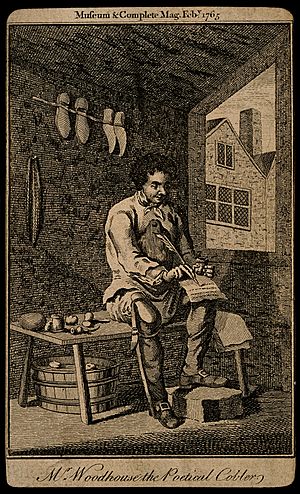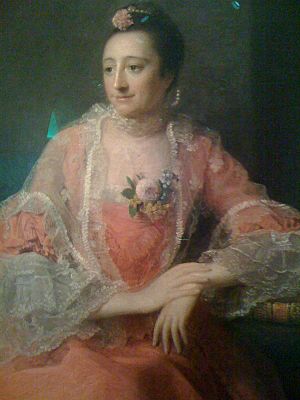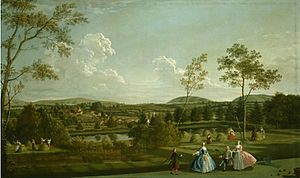James Woodhouse (poet) facts for kids
James Woodhouse (1735–1820) was an English poet from the Black Country village of Rowley Regis. He was known as the "shoemaker poet" because of his job. This trade helped him earn a living when he was young. He met another poet, William Shenstone, who lived nearby. Shenstone encouraged James to write poetry.
In 1764, a collection of James's poems was published. His friends helped pay for it. He became quite famous as a writer who came from "humble" (simple) beginnings. He found people who supported him financially, called "patrons." The most important patron was Elizabeth Montagu, a famous "bluestocking" (a smart, educated woman). She even hired him to work for her. After a disagreement with Montagu, he left her service. He spent his later years in London, where he started a bookselling business. James Woodhouse died in 1820 and was buried in London.
Contents
The Life of James Woodhouse
Growing Up in Rowley Regis
James Woodhouse was born in Rowley Regis, a village in the Black Country region of England, in 1735. His parents, Joseph and Mary Woodhouse, owned a farm. James was baptized at St. Giles church on April 18, 1735. At that time, the area around Rowley Regis was mostly countryside. However, many people in the area made nails by hand.
James left school at age seven, having only learned to read and write. He became a shoemaker, which was how he supported himself and his family. When he was eighteen, James developed a strong love for reading and learning. He spent all his small earnings on magazines. He started writing poems, which worried his father, who thought it was a distraction from his work. James also met the poet William Shenstone, who lived nearby at The Leasowes in Halesowen.
Becoming a Published Poet
William Shenstone had a beautiful estate called The Leasowes. He had designed the gardens to look like a natural, decorated farm. He used to let people visit his gardens for free. But in 1759, the public caused a lot of damage to the estate. So, Shenstone had to limit who could visit.
When James Woodhouse heard about the damage, he wrote a poem for Shenstone. The poem praised Shenstone and expressed sadness that the gardens had to be closed. From then on, Shenstone encouraged James's writing. He even let the shoemaker use his library. In January 1760, James married Hannah Fletcher. She is often called "Daphne" in his poems. They had six children who survived, and many who did not.
In 1763, one of James's poems about spring was included in a book series called The Poetical Calendar. However, James later said this was done without his permission and that the poem's text was not perfect. After Shenstone died in 1763, James managed to publish his own collection of poems. It was called "Poems on Sundry Occasions." His friends helped him by paying for it. The collection was published in 1764. In the same year, one of James's poems appeared in a book of William Shenstone's works.
By this time, James had a few children. He was earning extra money by teaching children to read and write. He also gained new supporters, or "patrons," who helped his career. These included George Lyttelton, 1st Baron Lyttelton and Elizabeth Montagu. In his first book, James also thanked John Ward, 1st Viscount Dudley and Ward for helping him get a free school job.
Being known as the "shoemaker poet" made James quite famous. He even met Samuel Johnson, a very important writer, in 1765. Johnson advised James to study the writer Addison if he wanted to improve his writing. However, Johnson also made some less kind comments about James. He said that people who supported poets like James were just showing off their own importance. He thought it would be better to give James good tools for shoemaking than to pay for his poems. Johnson believed James could be a great shoemaker but not a great poet.
In 1765, James had a bad experience at The Leasowes. While walking through Shenstone's old property, he was beaten by the new owner's servants. They did not recognize him.
In 1766, James published an expanded version of his first book, called Poems on Several Occasions. He dedicated this book to Lord George Lyttelton. Elizabeth Montagu also helped him get the money needed to publish it. In the introduction, James told his readers that his patrons' generosity allowed him to spend more time teaching at his small school.
Working for the Montagu Family
In 1767, James Woodhouse found a job as a land manager on the Sandleford estate. This estate belonged to Elizabeth and Edward Montagu. James and his family lived on the estate. At first, his relationship with the Montagus was good. Letters from Elizabeth Montagu show that James was a good manager. He worked long hours during harvest and supervised planting and other farm tasks. He also wrote poems for special events, like Elizabeth's birthday.
However, problems slowly grew between the Woodhouse family and Elizabeth Montagu. Their relationship became difficult. In 1778, James left his job and returned with his family to Rowley Regis. While back home, James lost one of his daughters, Martha, to smallpox. He made up with Elizabeth Montagu in 1781 and started working for her again. He became a steward at Sandleford and at her new home in London. But in 1788, James and Elizabeth had a final disagreement, this time about religion and politics. James left her service for good.
Later Life as a Bookseller and Poet
James spent his final years in London. He started a bookselling business with help from James Dodsley.
In 1788, James published a new book of poems, also called Poems on several occasions. This book had different poems than his 1766 collection. These were the first poems he published since working for the Montagus. The book included a section called "Address to the Public." In it, he talked about his financial struggles and having an "unhealthy wife, by whom I have had twenty-seven children." The book was sold from his shop in London.
James wrote many more poems in the following years. Some were published in the early 1800s. In 1803, he published Norbury Park and other poems. He dedicated this book to William Locke, the owner of Norbury Park. At this time, James had a shop on Oxford Street in London. The next year, he published a collection of poems written as letters, called Love letters to my wife.
He also wrote a long, funny poem about his own life called The Life and Lucubrations of Crispinus Scriblerus. Parts of this poem were published in 1815. But the full poem was only published much later, in 1896, by one of his descendants. The title of the poem likely refers to an earlier work by a group of 18th-century writers. "Crispin" is the patron saint of shoemakers. The poem includes a very critical description of Elizabeth Montagu. This is probably why the full poem was not published during James's lifetime.
A description of James in his later years was written in 1829. It said he was tall, straight, and looked very old and wise. He wore a black velvet cap and a long, black gown. He had a kind look on his face. When a customer came into his bookshop, he would walk out from his small back room with a grand step.
James Woodhouse died in 1820. His death was caused by being hit by a carriage while crossing the road. He was buried near Marble Arch in London. In his will, James left his property to his only surviving child, Elizabeth.
James Woodhouse's Poems
Many of James Woodhouse's early poems praised William Shenstone and his estate, The Leasowes. His first collection, published in 1764, included two poems for Shenstone. One was called "On his indisposition in the spring, 1762."
The first of these poems begins by asking Shenstone for forgiveness. It says that a simple village person dares to write about his famous name. It asks Shenstone not to frown but to keep his happy smile. The poem suggests that James's writing will never offend someone as good and friendly as Shenstone.
His first collection also included a poem called The Lessowes. A Poem. Other poems in this book were Benevolence, an Ode, and Spring.
James's second collection from 1766 included the poems from his earlier book. It also added new ones like Wrote at the Lessowes after Mr Shenstone's Death. There were also two poems for Lord Lyttelton.
His 1788 collection, Poems on several occasions, never before published, included new poems. These were "Ridicule," "An Elegy on a favourite Child who died of the small-pox" (written after his daughter Martha died in 1779), and "Elegy written in 1784."
James's next book, Norbury Park: A Poem : with Several Others, was published in 1803. Nearly half of the book was a long poem called Norbury Park: A Poem, dedicated to the park's owner, W. Lock. It also had five poems written as letters. One was to William Shenstone, who had already passed away. Other poems included "To my wife and children" and "To my wife, on her wishing to see me half an hour."
One poem, "Autumn and the Redbreast, An Ode," was for his wife, Hannah. It starts by saying that other poets sing about spring. But for James, spring has no charm because it takes him away from Hannah. He says that Hannah makes nature beautiful all year round.
In 1804, James published Love letters to my wife. This book had nine poems written as letters. Even though the title suggests love, the poems are mostly about morals and religion. A review at the time said that James used these poems to criticize the bad habits of rich people.
James Woodhouse's last major work was The Life and Lucubrations of Crispinus Scriblerus. Only parts of it were published during his lifetime, starting in 1815. The full poem was finally published in 1896 by a descendant. This poem tells James's life story. It is very long, with 28,000 lines.
The poem begins by remembering the Rowley Hills from James's childhood. It describes the hills and a "blessed spot" where a church stands. It then talks about a humble but honest couple who lived there.
Selected Works
- To William Shenstone Esq.; in his sickness, 1764
- Poems on sundry occasions, 1764
- Poems on several occasions, 1766
- Poems on several occasions, 1788
- Norbury Park and other poems, 1803
- Love letters to my wife, 1804
- The Life and Lucubrations of Crispinus Scriblerus, 1815 (complete poem published 1896)
See also
- List of 18th-century British working-class writers






